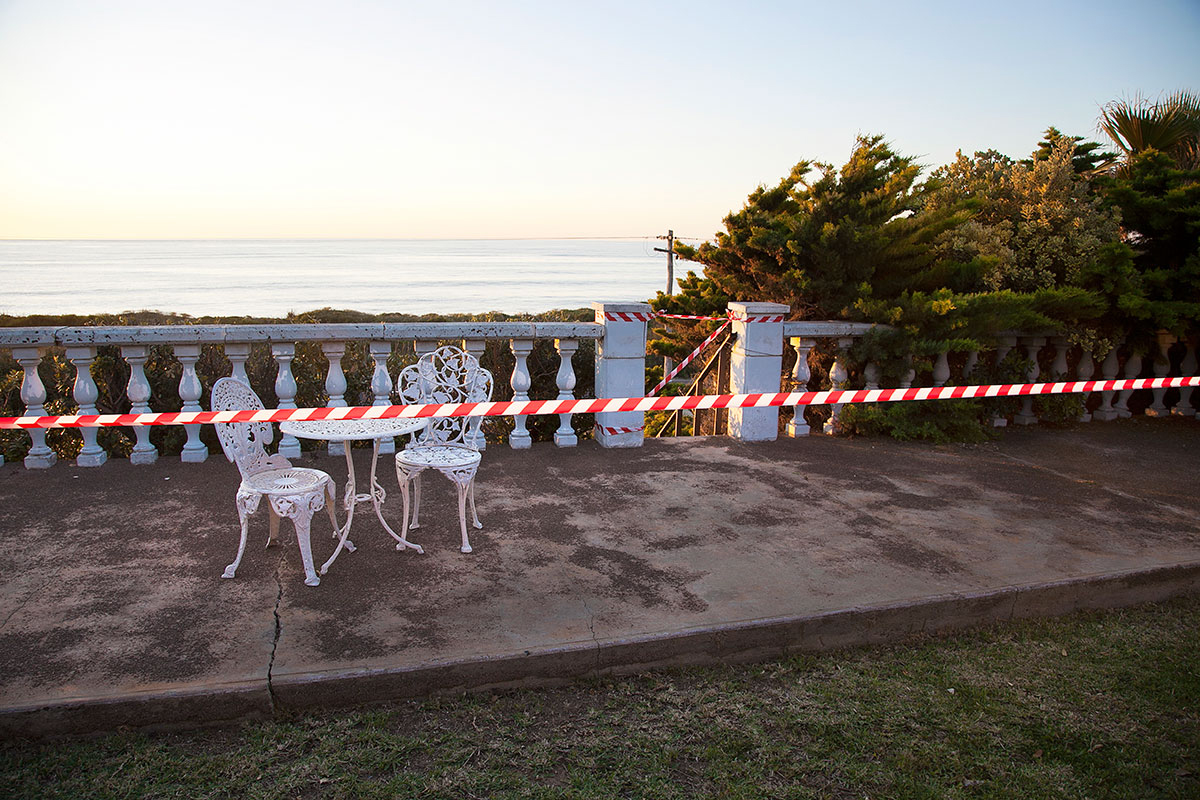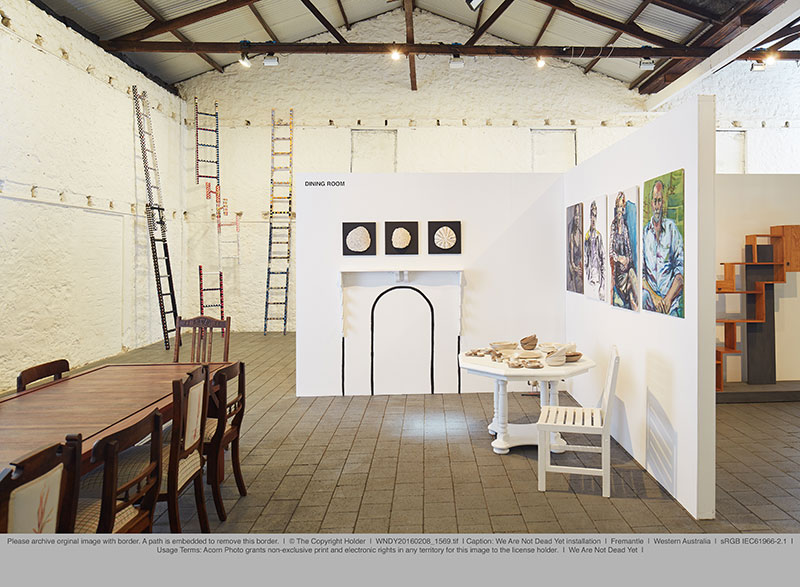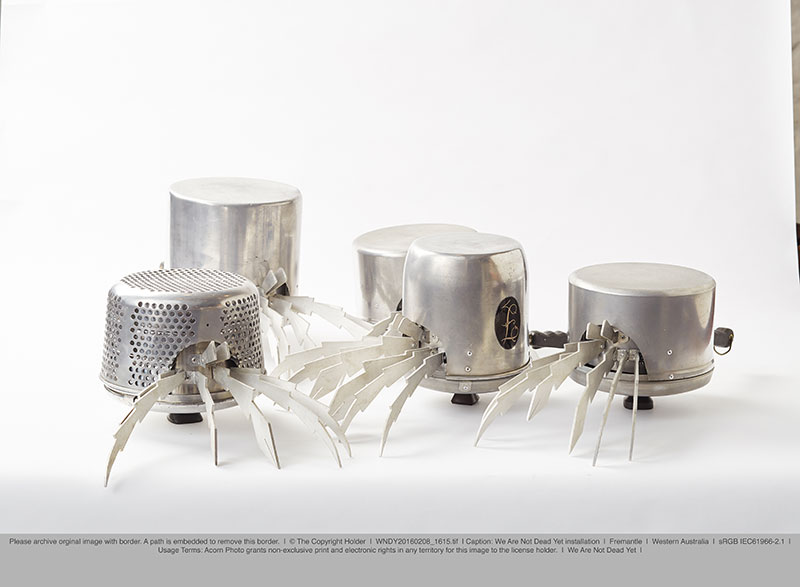
If you are a female artist aged over 50, are you invisible? Do funding streams bypass you? How are you treated differently to your male contemporaries and the young sprites in the industry? And what if you are in your 50s and starting out? How do the dynamics and social expectations of age and gender shape the way you are received? Not to mention the varying interpretations of the term “emerging”. And, indeed, what are the roles and responsibilities are that fall on the shoulders of curators, art critics and gallerists regarding this female demographic?
These were a handful of the questions tackled at the We Are Not Dead Yet Symposium associated with an exhibition of the same name curated by Anna Louise Richardson. The exhibition took place at the Moores Contemporary Art Gallery with six mature, largely unrecognised, Australian female artists – Megan Christie, Karen Millar, Daveena Cox, Lisa Dymond, Monique Bosshard Curby and Lyn Nixon. It marked a challenge to social preconceptions of the role of an artist as mother and as a woman pursuing a professional practice within an “invisible” demographic.
The exhibition literally unfolded as a home, from the outside of the building to the interior. It was set up as the rooms of a home, with the artworks displayed on or as furniture, including an ambitious selection of elaborate pieces by Christie. The clichés around female domesticity and dedication to the home and craft practices were teased apart. This was seen through the sculptural and feminine symbology of Dymond; the evocative paintings and drawings of Cox; Millar’s highly crafted ceramics referencing the natural world; Bosshard Curby’s exploration of themes of fragility and resilience through print and Nixon’s speculative photographs. Richardson acknowledges the formidable agency of these female artists practicing in their later years; domestic space is treated respectfully and playfully, with washes of poignant social critique. Both the exhibition and the symposium tackled the complex entanglements of work, life, family, age and opportunity.

The symposium echoed and refocused these themes through a strong selection of speakers – Polixeni Papapetrou, Megan Monte, Dunja Rmandic, Valerie Sparks and Jo Pollitt, moderated by Frances Barrett. Monte spoke about the role of curating through her position at Campbelltown Arts Centre. For Monte, the curator is an instigator, activator, facilitator and protagonist, someone who presents value, demystifies objects and generates an experience. The exhibition is the outcome of a full communicative process. Monte raised the key point of the vitality of communication and maintaining relationships across generations, arguing for the curator as a conversational catalyst, who defines the framework of an exhibition that is, ultimately, vested in the authority and ownership of the artist. But, as Dunja Rmandic reminded us, without the art and the artists the curator would have nothing to do. Monte brought the discussion around to the point that it is the responsibility of the curator to support inclusivity across age and gender.
As an artist dedicated to practice later in life, Papapetrou discussed the challenges of a female artist working with children, drawing from her own experience. She reiterated the well-known controversy that exploded in the media in 2008 with the reactions to her photographs of her daughter, Olympia, in the nude. Papapetrou was confounded by the accusations that came flying her way at the time and especially by being repeatedly labelled a “bad mother”. The troubling assumption was that if she was photographing her children in this manner she could not possibly be a nurturing mother. This highlighted the fact that female artists over 50 are not only faced by the threat of invisibility and everyday gender prejudices, but that they also encounter social assumptions about how a mother should act in the world. The point was made that male colleagues/partners are rarely asked what they are going to do with the kids when they take on a big job, while it is a common question put to female artists, regardless of age. Pollitt bemoaned the voice of the married woman with kids as not heard, but just as significant as any other – “I’m sorry I’m happy, got married, had kids and that it didn’t fall apart to feed a tortured art practice”.
The panel opened the discussion to a lively conversational fervour, teasing apart some of the key questions and focusing on the value of mentorship and intergenerational relationships. The significance and resonance of the term “feminist” was reiterated and although the discussion emphasised equality, the more realistic vision of equity amongst genders was barely mentioned. The tireless fact of continually confronting gender stereotyping came up. Sparks described being astounded at still being mistaken for a hobbyist in photography shops and the other speakers echoed this, with their experiences of not being taken seriously and shut out of conversations by their male contemporaries.
With the 98 per cent female audience, it was preaching to the converted. Barrett looked upon this humorously with the quip that “there is nothing more threatening to men than a group of women speaking”. The issues brought to the table were not unfamiliar; we have all heard them before, we can all relate to them, we live through them, as women in the arts (and the wider society). The sad thing is that despite this reiteration and despite the progress that has been made, these issues are still not being heard: changes are not being put into practice enough on the grand stage of exhibitions and collections locally, nationally and on the global circuit. It was persistently emphasised that curators, writers and artists need to be vigilant in addressing gender inequalities and inequities in the arts.


